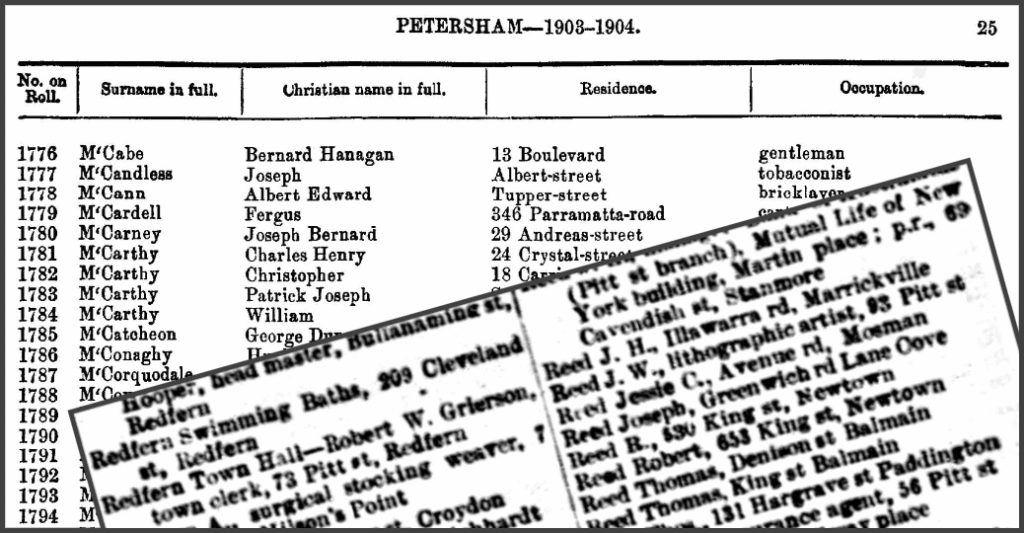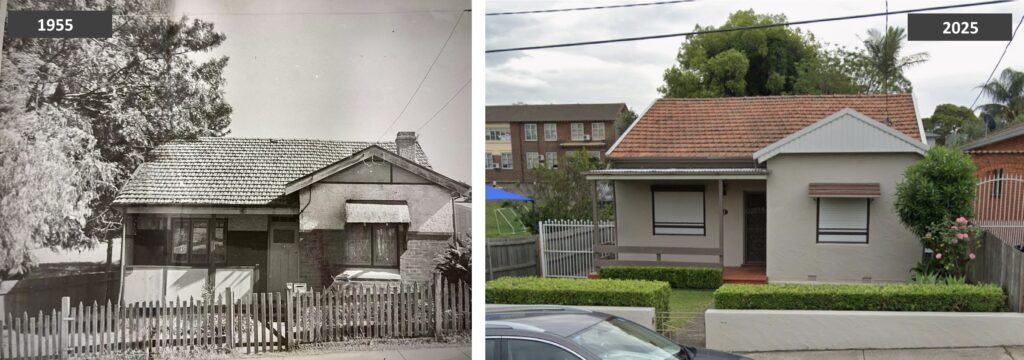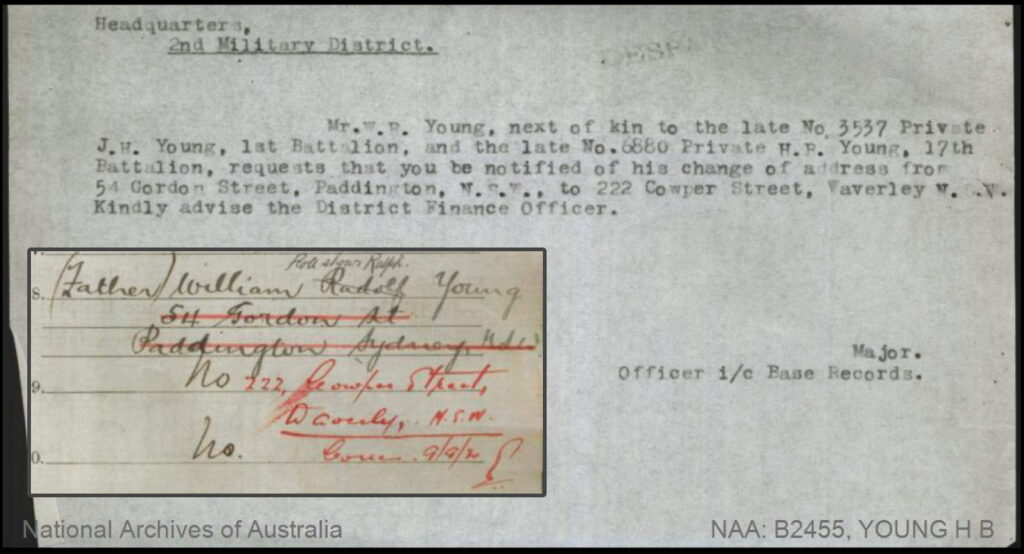Why Addresses Matter in Family History.
My late mother’s address book still lives in the top drawer of the kitchen in our family home. She always had it within easy reach. For her, it was practical and unpretentious: a small black book with Address Book stamped in gold on the front cover. The pages are a patchwork of entries in different coloured pens, pencil, and the occasional texta. Some addresses are neatly written; others crammed in sideways or added as afterthoughts. Over time, entire pages have become layered records of movement and connection. She always said she would re-write it one day but I’m so glad she didn’t get around to the task.

Do you have address books lying around that could provide valuable clues to your own family, neighbours, friends and associates?
It isn’t a decorative object, but a working tool, referred to regularly and always up to date in my mother’s mind, even when the written entries weren’t. We still refer to it as we try to track down a phone number or the name of a connection. “John’s address is on the right-hand side, going up the page,” she’d say, referring to a marginal note, confident in her mental map of where people were living now. If I quoted an address to her, she’d respond without hesitation: “That’s not the latest one.”
The busiest section in the book is under the letter R – our family name. That page is so full it spills over into the preceding pages under Q. My brothers and I each moved multiple times over the years, living in share houses, rental flats, and eventually buying homes in different parts of the country. Mum tracked each move with quiet precision, and we now have a record of our younger lives, some of which we ourselves have forgotten.
Since her passing, that address book has become more than just a household item. It’s a family heirloom. “Mum’s Book”, as we now call it includes distant cousins, exchange students hosted, friends made on overseas trips, and their families. It is a record of lifelong connections, growing and shifting across time zones and generations. It captures not only where people lived but the network of relationships that shaped our lives. For family historians, it’s a reminder of the value of place in our research.
Anchoring People in Time and Place

Snippets from Electoral Rolls and Sands Directories showing the wealth of information that can be gleaned from these records and prompting further research.
In family history, confirming identity is fundamental, especially when dealing with common names or multiple generations with the same first name. An address is a key tool for locating individuals in both time and place. When used in conjunction with other records, such as electoral rolls, post office directories, rate books, and land titles, addresses help establish timelines and clarify who lived where, and with whom.
For example, two men named William Jones might both have been born in Brisbane in the 1880s but locating them through their respective addresses in later records, especially when cross-referenced with occupations or family members, can confirm which is your ancestor and which is not.
The Role of Address in DNA Research

Placing historical photographs side by side with contemporary photos can show change over time. You may be lucky to find a house lived in by an ancestor is still standing.
The rise of DNA testing has added new avenues of research to family historians. While genetic matches offer potential connections, addresses can help determine which connection is likely. Identifying that a shared ancestor lived in a specific region, at a specific time, can provide critical evidence of biological parentage. And the address may only be referred to in a newspaper article rather than official documents.
Clusters of DNA matches living in or descending from the same area often point to a common ancestor. Old addresses can explain those links, helping to distinguish between multiple possible ancestors or identify connections across maternal and paternal lines.
Asking the Right Questions
An address in a record can open the door to a deeper investigation.
- Did the person own the property, or were they renting?
- Who else lived there at the same time?
- Does the building still exist? Has it changed over time?

Snippets from Harold Young war service record detailing change of address for next of kin.
A recent military service file I reviewed listed the home address of next of kin in inner Sydney. That address is now the site of a Catholic primary school. Further exploration of the file revealed a change of address of the serviceman’s father, with letters documenting these updates. And so, another investigation into the new address as well as trying to discover why he may have moved and is that property still in family hands? In another case, a 1930s divorce record held at the State Archives included photographs of the family home, still standing today with only minor renovations. These glimpses connect historical records to the present-day streetscape, creating a tangible link between generations.
Addresses also offer insight into personal circumstances. Changes of address can point to marriage, divorce, employment opportunities, financial shifts, or health concerns. A sudden move to a hospital, asylum, or boarding house may reflect significant life events not always spelled out in official records. And then there are those times when people seem to disappear, and we can’t locate them at all or there are large gaps in us being able to identify where an ancestor was living.
Technology and Tools for Address Research
Modern tools have transformed the way we trace historical addresses. Services such as Google Earth & street view allow researchers to examine properties using historical satellite imagery and overlayed maps, sometimes revealing buildings that have since been demolished or tracking the development of a neighbourhood over time. Online map repositories, including the National Library of Australia’s Trove map collection, offer access to historical street layouts, parish maps, and survey plans that help locate properties, even when modern addresses no longer align.
Local council archives and state library collections increasingly offer digitised rate books, valuation rolls, and property records, which can often be searched by address. Subscription sites including Ancestry and FindMyPast continue to add searchable electoral rolls, directories, and landholder indexes, further enhancing the ability to track a person or family through time and place.
Common Challenges in Address Research
Despite their value, addresses present several challenges for researchers. Street names and numbering systems frequently changed over time. After Federation, some streets were renamed to reflect national sentiment, while during the World Wars, German-sounding names were often anglicised. Suburban expansion often led to properties being renumbered—so “15 Smith Street” in 1920 might now be “47 Smith Street.” You may be lucky enough to have had a street named after an ancestor. But what was it known as before it received your ancestor’s name?

Snippets from Town Map of Wellington, NSW and Gazetted change of name of Montefiore Street to Whiteley Street, named after my great grandfather.
Rural addresses pose different difficulties. Descriptions based on now-vanished landmarks, such as “opposite the railway siding” or “past the old church,” can leave today’s researcher puzzled. These locations may no longer exist, requiring cross-referencing with maps, council records, or oral history to locate them accurately.
In urban areas, buildings may have been demolished, redeveloped, or subdivided, leaving only traces in insurance plans, building applications, or photographs. Complicating matters further, individuals did not always update their addresses consistently across records. A person might appear at their previous address on an electoral roll while having already moved, leading to apparent contradictions in the historical timeline.
Despite these challenges, researching property can be very worthwhile, revealing snippets that help to reconstruct our ancestors’ lives and confirm facts about their whereabouts and activities over time.
Your Address Matters Too

A starting idea for you to record the places you have lived. Add additional columns as needed to capture information specific to you. Can you find a photo of each place lived?
As family historians, we often focus on our ancestors’ records. But it’s worth considering how well our lives are documented for the generations to come. Have you ever written down all the places you’ve lived? Most of us can list recent homes, but over time, rental properties, university share houses, or overseas flats can be forgotten.
A simple list of your past addresses along with dates, memories, and even photographs can be a gift to your descendants. It might explain gaps in records, shifts in schooling, or the story behind a photo in an unfamiliar garden.
A Practical Challenge
Why not take the time this month to record your own address history? Start with your current home and work backwards. If you can, find photos of each place, or jot down a few lines about the people you lived with or what life was like at the time. This exercise isn’t just for your own reflection – it’s an investment in the future of your family’s historical record.
In the end, addresses are more than coordinates or contact details. They provide a framework for understanding movement, relationships, and change. They help us place people in the world, and by doing so, better understand their stories. And gather up those old address books as they will become the family heirlooms in years to come.

Oh Andrew! Your mum’s book brings back so many memories for me. My own mum said she had to buy a new book because I moved and got new phone numbers so many times. I was recently trying to recall all my previous addresses, and wishing I could consult her books!
Oh, what wonderful memories. I too have tried to remember all the places I’ve lived – hence the challenge at the end of the blog. Enjoy creating your list of “places you’ve lived.” Thanks for commenting.
I haven’t lived in too many places, so that is one thing I can document accurately from the hospital I was born in to my current abode.
That’s great John and even if only a few places, still an important record. Enjoy writing them down and reliving the memories.
Andrew your blog is a timely reminder to use all our resources and brings back so many memories for me . My mother also added death dates. If she liked the person she wrote ‘Dear Ethel died 16/4/53’. For some she didn’t like so much such as the husband of a friend too fond of a tipple she added ‘Lost Poor Bill 22/7/61’. Thank you for the previous address challenge, I am keen to start.
Wonderful and what little gems lay hidden alongside the addresses in your Mum’s address book. Good luck with the challenge of recording all your addresses.
Catching up after my recent overseas jaunt.
What a pertinent post that conjures up memories of Mum’s address book and its usefulness. Then there’s my Grandmother’s Birthday Book that has enabled me to identify dates for several people in my tree and to identify names of mysterious people I happen across thus allowing me to put them in their places in time.